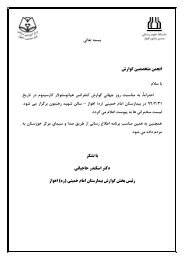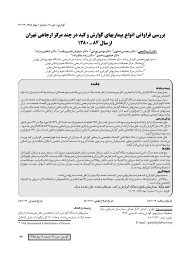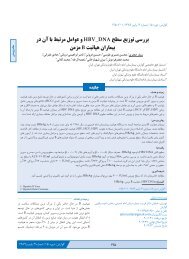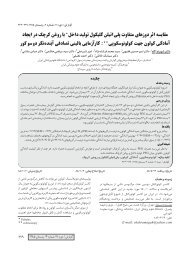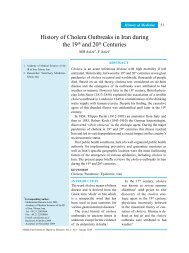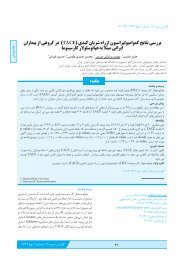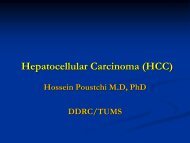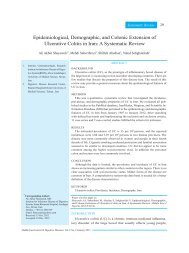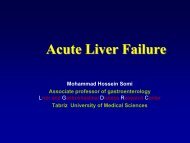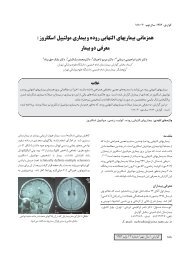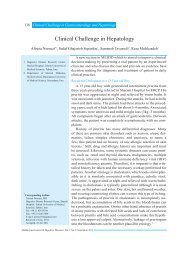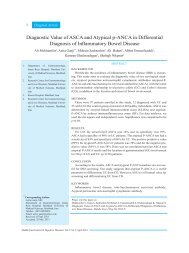Epidemiology of Peptic Ulcer Disease: Endoscopic Results of ... - IAGH
Epidemiology of Peptic Ulcer Disease: Endoscopic Results of ... - IAGH
Epidemiology of Peptic Ulcer Disease: Endoscopic Results of ... - IAGH
You also want an ePaper? Increase the reach of your titles
YUMPU automatically turns print PDFs into web optimized ePapers that Google loves.
90<br />
Original Article<br />
<strong>Epidemiology</strong> <strong>of</strong> <strong>Peptic</strong> <strong>Ulcer</strong> <strong>Disease</strong>: <strong>Endoscopic</strong> <strong>Results</strong> <strong>of</strong> a<br />
Systematic Investigation in Iran<br />
Farhad Barazandeh 1 , Abbas Yazdanbod 2 , Farhad Pourfarzi 2 , Sadaf Ghajarieh Sepanlou 1 , Mohammad H<br />
٭1 Derakhshan 3 , Reza Malekzadeh<br />
1.<br />
2.<br />
3.<br />
Digestive <strong>Disease</strong> Research Institute,<br />
Shariati Hospital, Tehran University<br />
<strong>of</strong> Medical Sciences, Tehran , Iran.<br />
Gastrointestinal Cancers Research<br />
Center (GICRC), Ardabil University<br />
<strong>of</strong> Medical Sciences, Ardabil, Iran.<br />
Section <strong>of</strong> Gastroenterology, Division <strong>of</strong><br />
Cardiovascular and Medical Sciences,<br />
University <strong>of</strong> Glasgow, Glasgow, UK.<br />
ABSTRACT<br />
BACKGROUND<br />
<strong>Peptic</strong> ulcer disease is a multifactorial health problem affecting almost<br />
all populations worldwide. Large scale population-based studies are crucial<br />
to understanding its scope and specifications in various nations. We<br />
aimed to explore environmental risk factors <strong>of</strong> peptic ulcer disease in the<br />
first population based study in Ardabil, Northwest Iran.<br />
METHODS<br />
This study was a part <strong>of</strong> a larger survey on upper gastrointestinal tract<br />
health conducted in Ardabil and Meshkinshahr with a total catchment<br />
area population <strong>of</strong> 600,000 persons during 2000-01. Using a random sampling<br />
proportional to place <strong>of</strong> residence, 1122 persons aged 40 or elder<br />
were selected. 1011 (90.1%) accepted participation and underwent a comprehensive<br />
medical examination and a systematic upper gastrointestinal<br />
endoscopy. Point prevalence <strong>of</strong> peptic ulcers was correlated to various<br />
life style risk factors.<br />
RESULTS<br />
Gastric and duodenal ulcers were identified in 33 (3.26%) and 50<br />
(4.94%) participants, making an overall prevalence <strong>of</strong> 8.20%. Based on<br />
multivariable logistic regression analyses, H.pylori infection (OR 3.1,<br />
95% CI: 2.1-4.7), Smoking (OR 1.8, 95% CI: 1.1-6.8), and chronic intake<br />
<strong>of</strong> NSAIDs (OR 2.8, 95% CI: 1.3-4.4) were main risk factors <strong>of</strong> gastric<br />
ulcer. For duodenal ulcer, in addition to H.pylori infection (OR 5.6, 95%<br />
CI: 1.9-8.8) and Smoking (OR 2.3, 95% CI: 1.4-6.5), male gender (OR<br />
3.6, 95% CI: 1.2-5.8) and living in an urban area (OR 1.9, 95% CI: 1.1-<br />
5.2) were among significant risk factors.<br />
CONCLUSION<br />
This is the first population-based endoscopic study in North West <strong>of</strong><br />
Iran reporting accurate point prevalence <strong>of</strong> peptic ulcer disease. The rate<br />
<strong>of</strong> 3.3% for gastric ulcer and 4.9% for duodenal ulcers are substantially<br />
lower than the estimates reported in Asian population-based endoscopic<br />
studies but higher than European reports.<br />
KEYWORDS<br />
H.pylori; <strong>Peptic</strong> ulcer disease; <strong>Epidemiology</strong>.<br />
* Corresponding Author:<br />
Reza Malekzadeh, MD<br />
Pr<strong>of</strong>essor, Digestive <strong>Disease</strong> Research<br />
Institute, Shariati Hospital, Tehran University<br />
<strong>of</strong> Medical Sciences, Tehran, Iran.<br />
Tel: + 98 21 82415106<br />
Fax:+ 98 21 82415400<br />
Email: malek@ams.ac.ir<br />
Received: 10 Jan. 2012<br />
Accepted: 20 Feb. 2012<br />
Please cite this paper as:<br />
Barazandeh F, Yazdanbod A, Pourfarzi F, Derakhshan M, Ghajarieh Sepanlou S, Malekzadeh R.<br />
<strong>Epidemiology</strong> <strong>of</strong> <strong>Peptic</strong> <strong>Ulcer</strong> <strong>Disease</strong>: <strong>Endoscopic</strong> <strong>Results</strong> <strong>of</strong> a Systematic Investigation<br />
in Iran. Middle East J Dig Dis 2012;4:90-6.<br />
Introduction<br />
Clinical symptoms are not enough for accurate diagnosis <strong>of</strong> peptic<br />
ulcer disease (PUD) and endoscopic assays are necessary for confirmation<br />
<strong>of</strong> diagnosis. 1-3 Despite previous studies in Europe and East Asia, 4-6<br />
there were no population-based endoscopic study for evaluation<br />
<strong>of</strong> prevalence <strong>of</strong> PUD in Iran. Previous studies were based on patients<br />
Middle East Journal <strong>of</strong> Digestive <strong>Disease</strong>s/ Vol.4/ No.2/ April 2012
Barazandeh et al. 91<br />
self-reports during referrals, following appearance<br />
<strong>of</strong> gastrointestinal symptoms in patients. Subsequently,<br />
conducting an epidemiological PUD survey<br />
was very important in our study area, particularly<br />
due to high prevalence <strong>of</strong> PUD complications. 7 The<br />
complications <strong>of</strong> PUD impose substantial economic<br />
and morbidity burden on the health system and the<br />
society. We did not have comprehensive economical<br />
studies in our area, but according to literature,<br />
the total costs <strong>of</strong> PUD in USA (both direct and indirect<br />
due to loss <strong>of</strong> work output) has been estimated<br />
to reach 6.46 billion USD per year. 8-9 On the other<br />
hand, gastric cancer in Northern Iranian provinces<br />
is quite common, while it is known that gastric ulcers<br />
might later lead to gastric cancers. 10-12<br />
In a series <strong>of</strong> collaborations between the Digestive<br />
<strong>Disease</strong> Research Center (DDRC) <strong>of</strong> Tehran<br />
University <strong>of</strong> Medical Sciences and Ardabil University<br />
<strong>of</strong> Medical Sciences aiming to formulate a<br />
preventive strategy for gastric cancer in Ardabil, we<br />
sought to endeavor an endoscopy-based exploratory<br />
study to determine the PUD prevalence and risk<br />
factors in residents <strong>of</strong> two major districts <strong>of</strong> Ardabil<br />
Province. We assessed the prevalence <strong>of</strong> Helicobacter<br />
pylori (H. Pylori) and its relation with the<br />
aforementioned factors as well.<br />
MATERIALS AND METHODS<br />
Study participants<br />
First part <strong>of</strong> the study was conducted between<br />
January and September 2000 in the district <strong>of</strong> Ardabil,<br />
North-West <strong>of</strong> Iran with a catchment area population<br />
<strong>of</strong> 435,487 persons. The second part was<br />
conducted in Meshkinshahr district, with catchment<br />
area population <strong>of</strong> 164,007 persons between<br />
July and September 2001. Selected regions <strong>of</strong> each<br />
district were included 17 villages in Ardabil and 19<br />
villages in Meshkinshahr. The pr<strong>of</strong>essional local<br />
health experts interviewed with all family members<br />
<strong>of</strong> the participants who were above 40 years old to<br />
achieve a sample size <strong>of</strong> 1122. After thorough explanation<br />
<strong>of</strong> the purpose and the procedure <strong>of</strong> the<br />
study, one individual within the target age, was randomly<br />
selected from each family. Our exclusion criteria<br />
were no inclination to participate at any stage<br />
<strong>of</strong> the study for any reason, inability to tolerate the<br />
upper gastrointestinal (GI) endoscopy for any reason,<br />
quoted during the interview or within the procedural<br />
time. The current or previous medical history<br />
<strong>of</strong> GI problem and any known benign or malignant<br />
upper GI disease was asked from the participants.<br />
All <strong>of</strong> the willing participants were transferred to<br />
the study site on the appointed day.<br />
The purpose <strong>of</strong> our study, including the risks<br />
and benefits were thoroughly explained on the appointed<br />
day and written consent form was obtained<br />
from all participants. The study protocol, physical<br />
examinations, diagnostic techniques and consent<br />
form were approved by DDRC ethics committee <strong>of</strong><br />
Tehran University <strong>of</strong> Medical Sciences.<br />
Before endoscopy, a questionnaire with special<br />
sections including dietary habits, demographic information,<br />
life style, smoking history, drug abuse,<br />
alcohol consumption and medication history was<br />
filled out for all participants. Each participant was<br />
interviewed by a trained general practitioner. They<br />
were also asked about GI symptoms and upper GI<br />
malignancy alarming signs, in the first or second<br />
degree relatives. After the interview, physical examinations<br />
<strong>of</strong> selected individuals were performed.<br />
Thereafter, they underwent standard endoscopy by<br />
cardiopulmonary monitoring and local anesthesia <strong>of</strong><br />
pharyngeal mucosa with 10% lidocaine spray and<br />
sedation with Midazolam. The endoscopic findings<br />
and a special endoscopy report form were recorded<br />
using an appropriate coding system for different lesions.<br />
Gastric biopsies for urease test were taken,<br />
from all observed lesions by trained assistant pathologist<br />
in the endoscopy room, and its result was<br />
recorded in related endoscopy form. In the next<br />
step, these samples were located immediately in a<br />
neutral buffered formalin solution and labeled by<br />
the individual , s name for further pathologic assays.<br />
The species were transferred to DDRC research<br />
laboratory in the city <strong>of</strong> Tehran. After endoscopy,<br />
the participants were transferred to recovery room and if<br />
general condition was acceptable, they were discharged.<br />
Statistical analysis<br />
Numerical data are expressed as mean ± SD.<br />
Middle East Journal <strong>of</strong> Digestive <strong>Disease</strong>s/ Vol.4/ No.2/ April 2012
92<br />
<strong>Epidemiology</strong> <strong>of</strong> <strong>Peptic</strong> <strong>Ulcer</strong> <strong>Disease</strong><br />
Pearson Chi square or Fisher’s exact tests were<br />
used to examine relationships between categorical<br />
variables, where appropriate. Associations between<br />
PUD and education, age and BMI were expressed<br />
using p value for trend. We made separate multivariable<br />
logistic regression models (stepwise method)<br />
for DU and GU to determine main risk factors<br />
<strong>of</strong> PUD. P values less than 0.05 were considered<br />
significant. Data analysis was performed using<br />
SPSS statistical package version 16.0 (SPSS Inc.<br />
Chicago, Illinois, USA).<br />
RESULTS<br />
Study participants<br />
Of initial 1122 selected and eligible persons,<br />
1011 individuals (90.1%) accepted to participate<br />
in the study. Among them, 494 (48.8%) were men<br />
and 517 (51.2%) were women. The mean age was<br />
53.25±10.38 years (ranging from 40 to 92 years).<br />
Among the participants, 539 (53.3%) were residants<br />
<strong>of</strong> Ardabil and Meshkinshahr cities and the<br />
remaining 434 (46.7%) were from rural areas. The<br />
mean body mass index (BMI) <strong>of</strong> our participants<br />
was measured to be 27±4.7kg/m 2 while most <strong>of</strong><br />
our subjects had BMI between 25 and 30kg/m 2 .<br />
Their literacy level included none (76%), secondary<br />
(16.5%), advanced (5.6%) and primary (1.9%)<br />
respectively. Most <strong>of</strong> the volunteers were from low<br />
socioeconomic groups <strong>of</strong> the society, appreciating<br />
free <strong>of</strong> charge screening, and their literacy level was<br />
lower than the average Iranian population (75% literate).<br />
Among the participants, 302 (29.9%), 18(1.8%)<br />
and 35 (3.5%) had tobacco smoking, opium addiction<br />
and alcohol consumption, respectively. Even<br />
though there was no statistically significant difference<br />
in the prevalence <strong>of</strong> digestive complaints, 539<br />
(52.9%) and 443 (43.8%) <strong>of</strong> the participants reported<br />
heart burn and epigastric pain, respectively.<br />
GI symptoms <strong>of</strong> heart burn, regurgitation, GI<br />
medication use related to gastric or duodenal ulcers;<br />
and GI alarm signs such as dysphasia as<br />
symptoms <strong>of</strong> upper GI malignancy were analyzed<br />
in our patients. The frequency <strong>of</strong> these manifestations<br />
and their relationship with PUD in endoscopy<br />
is calculated and presented in table 1. The majority<br />
<strong>of</strong> patients with PUD had none <strong>of</strong> the upper gastrointestinal<br />
symptoms. In symptom defined gastroesophageal<br />
reflux disease, heart burn was significantly<br />
more common in normal adults than patients<br />
with PUD, however there was no significant association<br />
between retrosternal pain and PUD. Also<br />
vague persistent abdominal pain and dyspepsia<br />
medication use was significantly more common in<br />
PUD patients than normal subjects. Among gastrointestinal<br />
alarm symptoms, weight loss in last 12<br />
months was more common in PUD patients.<br />
Table 1: Symptom pr<strong>of</strong>ile <strong>of</strong> peptic ulcer disease in cases and controls.<br />
Symptom/History<br />
Cases N (%) Controls N (%) p - value<br />
Retrosternal Pain Gastric <strong>Ulcer</strong> 15 (55.6) 218 (46.9) 0.380<br />
Duodenal <strong>Ulcer</strong> 18 (40.9) 218 (46.9) 0.448<br />
Heartburn Gastric <strong>Ulcer</strong> 9 (27.3) 245 (52.7) 0.005<br />
Duodenal <strong>Ulcer</strong> 31 (68.9) 245 (52.7) 0.037<br />
Dysphagia to Gastric <strong>Ulcer</strong> 3 (11.5) 72 (15.5) 0.782 f<br />
solids Duodenal <strong>Ulcer</strong> 8 (16.7) 72 (15.5) 0.924<br />
Dysphagia to Gastric <strong>Ulcer</strong> 1 (3.7) 42 (9.0) 0.497 f<br />
liquids Duodenal <strong>Ulcer</strong> 3 (6.4) 42 (9.0) 0.787 f<br />
Vague persistent Gastric <strong>Ulcer</strong> 22 (66.7) 118 (25.4)
Barazandeh et al.<br />
93<br />
men than women and most <strong>of</strong> subjects with gastric<br />
ulcer were married and lived in rural areas. There<br />
were not statistically significant differences in gender<br />
(p=0.17), age (p=0.51), area <strong>of</strong> living (p=0.57),<br />
literacy level (p=0.75), and marital status (p=0.07)<br />
between participants with or without gastric ulcers.<br />
Gastric ulcer was associated with smoking and<br />
chronic NSAIDS use (>3 months vs. non or short<br />
term use).<br />
As for duodenal ulcers (Table 3), they were similarly<br />
more common in men and married individuals<br />
with low literacy level, while most <strong>of</strong> them were<br />
living in urban areas. The association between some<br />
<strong>of</strong> these variables (gender, region, literacy, marital<br />
and smoking statues) with duodenal ulcers was significant<br />
(p
94<br />
<strong>Epidemiology</strong> <strong>of</strong> <strong>Peptic</strong> <strong>Ulcer</strong> <strong>Disease</strong><br />
Table 3: Demographic and life style characteristics <strong>of</strong> individuals with<br />
duodenal ulcer and their controls.<br />
Factor With DU Without DU Statistical Test<br />
N (%) N (%) p -value<br />
Gender Men 38 (76.0) 456 (47.5) < 0.001<br />
Women 12 (24.0) 505 (52.5)<br />
Age (year) 40-49 26 (52.0) 430 (44.7) 0.757<br />
50-59 12 (24.0) 242 (25.2) p- value for<br />
60-69 9 (18.0) 212 (22.1) trend = 0.286<br />
≥ 70 3 (6.0) 77 (8.0)<br />
Residence Urban 37 (74.0) 502 (52.2) 0.003<br />
Rural 13 (26.0) 460 (47.8)<br />
Education Non 27 (54.0) 773 (77.2) 0.001<br />
Primary 5 (10.0) 72 (7.6) p- value for<br />
Secondary 12 (24.0) 95 (10.0) trend < 0.001<br />
Graduate/<br />
postgraduate<br />
6 (12.0) 50 (5.3)<br />
Marital Married 48 (98.0) 820 (85.6) 0.010<br />
Status Single/ 1 (2.0) 138 (14.4) (Fisher’s exact<br />
Divorced/<br />
test)<br />
widow<br />
Tobacco Current 25 (51.0) 253 (26.8) < 0.001<br />
smoker<br />
Non smoker 24 (49.0) 691 (73.2)<br />
BMI < 18.5 0 (0) 12 (1.6) 0.002<br />
18.5 – 24.9 13 (26.0) 301 (38.9)<br />
25.0 – 29.9 32 (64.0) 288 (37.2)<br />
≥ 30 5 (10.0) 173 (22.4)<br />
Table 4: Relationship between gastric ulcer and BMI presented as<br />
quintiles.<br />
BMI Quintiles With GU Without GU Statistical Test<br />
1 st : < 22.89 10 (32.3%) 154 (19.4%) Pearson Chi<br />
Square= 0.001<br />
2 nd : 22.89 - 25.13 12 (38.7%) 154 (19.4%)<br />
3 rd : 25.13 - 27.39 5 (16.1%) 160 (20.2%) p value for<br />
trend < 0.001<br />
4 th : 27.39 - 30.32 1 (3.2%) 164 (20.7%)<br />
5 th : > 30.32 3 (9.7%) 162 (20.4%)<br />
Table 5: Relationship between duodenal ulcer and BMI presented as<br />
quintiles.<br />
BMI Quintiles With GU Without GU Statistical Test<br />
1 st : < 22.89 4 (8.0%) 160 (20.6%) Pearson Chi<br />
Square = 0.001<br />
2 nd : 22.89 - 25.13 9 (18.0%) 157 (20.3%)<br />
3 rd : 25.13 - 27.39 16 (32.0%) 149 (19.2%) p value for<br />
trend = 0.474<br />
4 th : 27.39 - 30.32 18 (36.0%) 147 (19.0%)<br />
5 th : > 30.32 3 (6.0%) 162(20.9%)<br />
patients with gastric ulcer. In patients with duodenal<br />
ulcer, risk factors included H.Pylori infection,<br />
smoking, male gender, and living in urban areas<br />
(Tables 6-7).<br />
Table 6: Significant environmental risk factors for gastric ulcer in residents<br />
<strong>of</strong> Ardabil province; results <strong>of</strong> final step <strong>of</strong> multivariable logistic<br />
regression analysis.<br />
Risk Factor OR (95 % CI) p- value<br />
H.pylori infection positive vs. negative 3.1 (2.1 – 4.7) 0.002<br />
Smoking Current vs. non 1.8 (1.1 – 6.8) 0.034<br />
Chronic (> 3 months vs. 2.8 (1.3 – 4.4) 0.019<br />
NSAID intake non or short-term)<br />
Nagelkerke R Square = 0.586, method: Stepwise (Backward likelihood)<br />
Table 7: Significant environmental risk factors for duodenal ulcer in<br />
residents <strong>of</strong> Ardabil province; results <strong>of</strong> final step <strong>of</strong> multivariable<br />
logistic regression analysis.<br />
Risk Factor OR (95 % CI) p -value<br />
H.pylori infection positive vs. negative 5.6 (1.9 – 8.8) 0.001<br />
Smoking Current vs. non 2.3 (1.4 – 6.5) 0.026<br />
Gender Men vs. women 3.6 (1.2 – 5.8) 0.008<br />
Residence Urban vs. Rural areas 1.9 (1.1 – 5.2) 0.039<br />
Nagelkerke R Square = 0.637, method: Stepwise (Backward likelihood)<br />
DISCUSSION<br />
This is the first population-based endoscopic<br />
study in North West <strong>of</strong> Iran that reports PUD prevalence<br />
up to 3.3 and 4.9 percent for gastric and duodenal<br />
ulcers respectively. This rate is substantially<br />
lower than prevalence estimates reported in previous<br />
Asian population-based endoscopic studies. 13-15<br />
As Li et al. 16 found in their systematic investigation<br />
<strong>of</strong> gastrointestinal diseases, the prevalence <strong>of</strong> PUD<br />
in China reaches 17.2% (gastric ulcer: 6.1%; duodenal<br />
ulcer: 13.3%). Also the annual global incidence<br />
rates <strong>of</strong> PUD rates have been reported around<br />
0.1-0.19% for in physician <strong>of</strong>fice-diagnosed PUDs<br />
and 0.03-0.17 for hospitalization records. 17 However,<br />
our findings are more close to European endoscopic<br />
epidemiologic studies, 4,6 as they reported<br />
prevalence rates from 4.1 % (gastric ulcer: 2.0 %;<br />
duodenal ulcer: 2.1 %), 4 to 6.2 % (gastric ulcer: 2.3<br />
%; duodenal ulcer: 3.9 %). 6<br />
Middle East Journal <strong>of</strong> Digestive <strong>Disease</strong>s/ Vol.4/ No.2/ April 2012
Barazandeh et al.<br />
95<br />
As for microbiological studies, high prevalence<br />
<strong>of</strong> H.pylori infection (73.3%/10130 individuals) has<br />
been demonstrated in a Chinese study. 16 H.pylori<br />
infection as a major cause <strong>of</strong> PUD, 18 was found in<br />
73-100% <strong>of</strong> the patients with duodenal ulcers and<br />
65-100% <strong>of</strong> patients with gastric ulcer. 19-23 During a<br />
10-year study in Korea, Jang et al. 24 found out that<br />
the prevalence <strong>of</strong> PUD and mainly that <strong>of</strong> duodenal<br />
ulcers had a decreasing trend. The incidence <strong>of</strong><br />
duodenal ulcers in western population is steadily<br />
decreasing due to better hygiene and sanitation and<br />
administration <strong>of</strong> proper regimes for H.pylori eradication.<br />
25<br />
In the present study, we found that nearly all<br />
individuals with PUD (93.9% for gastric ulcer<br />
and 100% for duodenal ulcer) were infected with<br />
H.pylori. The high prevalence <strong>of</strong> H.pylori infection<br />
in PUD was in accordance with Chinese endoscopic<br />
studies (92.6%), 13-16 and in contrast with European<br />
studies (33.9%, 57.7%). 4,6 It was also possible that<br />
the Chinese population may have similar prevalence<br />
<strong>of</strong> ulcerogenic strains <strong>of</strong> H. pylori to Iran.<br />
In contrast to the result <strong>of</strong> the European population-based<br />
studies, 4,6 and in accord with Li et al. 16<br />
we found no association between PUD and reflux<br />
esophagitis, although reflux esophagitis was numerically<br />
more common in individuals with PUD.<br />
Frank et al. evaluated the prevalence <strong>of</strong> upper<br />
gastrointestinal symptoms and its relation to health<br />
care utilization and quality <strong>of</strong> care. They found that<br />
individuals suffering from GERD and ulcer had<br />
more physician visits for their symptoms. 26 Gastrointestinal<br />
reflux disease appears to be increasing, 27<br />
according to several epidemiological symptoms,<br />
particularly due to related life style factors such as<br />
diet and obesity. 28,29 Smoking, aspirin consumption,<br />
and obesity were risk factors for 4.1% prevalence<br />
<strong>of</strong> PUD in northern Sweden. 4 Although we did not<br />
evaluate the care utilization <strong>of</strong> the patients with<br />
PUD, there was no association between heart burn<br />
and GERD. While among 50-60% <strong>of</strong> our studied<br />
PUD patients with heart burn, association between<br />
heart burn (60%) and GERD was demonstrated.<br />
Based on the multivariate analysis, H.Pylori infection,<br />
current smoking, and chronic NSAID intake<br />
were the main environmental risk factors associated<br />
with gastric ulcer. On the other hand, for<br />
duodenal ulcer, H.Pylori infection, current smoking,<br />
male gender, and urban residence were the<br />
main risk factors.<br />
Generally speaking, our results might actually reflect<br />
the association <strong>of</strong> high prevalence <strong>of</strong> H.pylori<br />
infection with PUD in Iran. Moreover, this strong<br />
association may be an explanation for extremely<br />
high prevalence <strong>of</strong> atrophic gastritis in gastric<br />
ulcers.<br />
Concluding, there is a paradox between the prevalence<br />
<strong>of</strong> PUD and H. pylori infection in our study<br />
findings in comparison with those <strong>of</strong> Asian and European<br />
studies. We know that the diet <strong>of</strong> Iranians<br />
contains high amounts <strong>of</strong> saturated fat and protein,<br />
which is more similar to Europeans while on the<br />
other hand, the current level <strong>of</strong> hygiene and sanitation<br />
in regions in our study is mostly identical to<br />
those in Asian studies. In short, it seems that the<br />
first explains why our PUD prevalence is close to<br />
Europeans and the latter explains why the pattern<br />
<strong>of</strong> H.Pylori infection mimics Asians. If this hypothesis<br />
is assumed to be accurate, it confirms that PUD<br />
is a multi-factorial disorder and multidimensional<br />
health strategies are required to overcome it.<br />
Conflict <strong>of</strong> interest<br />
The authors declare no conflict <strong>of</strong> interest related to<br />
this work.<br />
References<br />
1.<br />
2.<br />
3.<br />
4.<br />
Vakil N, Dent J , Jones R Lind T, Junghard O. The accuracy<br />
and predictors <strong>of</strong> a clinical diagnosis <strong>of</strong> dyspepsia or peptic<br />
ulcer disease by gastroenterologists and family practitioners.<br />
Gastroenterology 2008;134:A629.<br />
Lydeard S, Jones R. Factors affecting the decision to consult<br />
with dyspepsia: comparison <strong>of</strong> consulters and non-consulters.<br />
J R Coll Gen Pract 1989;39:495–8.<br />
Howell S, Talley NJ. Does fear <strong>of</strong> serious disease predict<br />
consulting behaviour amongst patients with dyspepsia<br />
in general practice Eur J Gastroenterol Hepatol<br />
1999;11:881–6.<br />
Aro P, Storskrubb T, Ronkainen J, Bolling-Sternevald E,<br />
Engstrand L, Vieth M,et al. <strong>Peptic</strong> ulcer disease in a general<br />
adult population: the Kalixanda study: a random population-based<br />
study .Am J Epidemiol 2006;163:1025 – 34.<br />
Middle East Journal <strong>of</strong> Digestive <strong>Disease</strong>s/ Vol.4/ No.2/ April 2012
96<br />
<strong>Epidemiology</strong> <strong>of</strong> <strong>Peptic</strong> <strong>Ulcer</strong> <strong>Disease</strong><br />
5.<br />
6.<br />
7.<br />
8.<br />
9.<br />
10.<br />
11.<br />
12.<br />
Zagari RM, Fuccio L, Wallander MA, Johansson S, Fiocca<br />
R, Casanova S, et al. Gastro-oesophageal reflux symptoms,<br />
oesophagitis and Barrett’s oesophagus in the general population:<br />
Loiano-Monghidorostudy . Gut 2008;57:1354 – 9.<br />
Zagari RM, Law GR, Fuccio L, Pozzato P, Forman D, Bazzoli<br />
F. Dyspeptic symptoms and endoscopic findings in<br />
the community: the Loiano-Monghidoro study. Am J Gastroenterol<br />
2010;105;565 – 71.<br />
Bian ZQ ,Hua ZL , Zheng DQ . Endoscopy analysis and<br />
epidemiology analysis <strong>of</strong> peptic ulcer . Chin J Digest<br />
2008;28;460 – 3.<br />
Talley NJ, Fung LH, Gilligan IJ, McNeil D, Piper DW.<br />
Association <strong>of</strong> anxiety,neuroticism, and depression with<br />
dyspepsia <strong>of</strong> unknown cause. A case-control study. Gastroenterology<br />
1986;90:886–92.<br />
Sonnenberg A, Everhart JE. Health impact <strong>of</strong> peptic ulcer<br />
in the United States. Am J Gastroenterol 1997; 92:614-20.<br />
Nadim A, Noorai M. Cancers. In: Azizi F, Hatami H, Janghorbani<br />
M, eds. <strong>Epidemiology</strong> and control <strong>of</strong> common diseases<br />
in Iran, 1st ed. Tehran: Eshtiagh, 2000:216–7.<br />
Naghavi M. Death report from 10 provinces in Iran, 1st ed.<br />
Tehran: Ministry <strong>of</strong> Health, 2000: 384.<br />
Sadjadi AR, Malekzadeh R, Derakhshan MH, Sepehr A,<br />
Nouraie M, Sotoudeh M, et al. Cancer occurrence in Ardabil:<br />
results <strong>of</strong> a population based cancer registry from<br />
Iran. Int J Cancer 2003;107:113–8.<br />
21.<br />
22.<br />
23.<br />
24.<br />
25.<br />
26.<br />
27.<br />
ulcer. Am J Gastroenterol 1991;86:1154–7.<br />
Kuipers EJ, Thijs JC, Festen HP. The prevalence <strong>of</strong> Helicobacter<br />
pylori in peptic ulcer disease. Aliment Pharmacol<br />
Ther 1995;9:59–69.<br />
Tsuji H, Kohli Y, Fukumitsu S, Morita K, Kaneko H, Ohkawara<br />
T, et al. Helicobacter pylori negative gastric and<br />
duodenal ulcers. J Gastroenterol 1999;34:455–60.<br />
Meucci G, Di Battista R, Abbiati C, Benassi R, Bierti L,<br />
Bortoli A, et al. Prevalence and risk factors <strong>of</strong> Helicobacter<br />
pylori-negative peptic ulcer: a multicenter study. J Clin<br />
Gastroenterol 2000;31:42–7.<br />
Jang HJ, Choi MH, Shin WG, Kim KH, Chung YW, Kim<br />
KO, et al. Has peptic ulcer disease changed during the past<br />
ten years in Korea A prospective multi-center study. Dig<br />
Dis Sci 2008;53:1527-31.<br />
Groenen MJ, Kuipers EJ, Hansen BE, Ouwendijk RJ. Incidence<br />
<strong>of</strong> duodenal ulcers and gastric ulcers in a Western<br />
population: back to where it started. Can J Gastroenterol<br />
2009;23:604-8.<br />
Frank L, Kleinman L, Ganoczy D, McQuaid K, Sloan S,<br />
Eggleston A, et al. Upper gastrointestinal symptoms in<br />
North America: prevalence and relationship to healthcare<br />
utilization and quality <strong>of</strong> life. Dig Dis Sci 2000;45:809-18.<br />
El-Serag HB. Time trends <strong>of</strong> gastroesophageal reflux<br />
disease: a systematic review. Clin Gastroenterol Hepatol<br />
2007;5:17–26.<br />
13.<br />
14.<br />
Xia B, Xia HH, Ma CW ,Wong KW, Fung FM, Hui CK,<br />
et al. Trends in the prevalence <strong>of</strong> peptic ulcer disease and<br />
Helicobacter pylori infection in family physician-referred<br />
uninvestigated dyspeptic patients in Hong Kong. Aliment<br />
Pharmacol Ther 2005;22:243 – 9.<br />
Wong SN, Sollano JD, Chan MM , Carpio RE, Tady CS, Ismael<br />
AE,, et al. Changing trends in peptic ulcer prevalence<br />
in a tertiary care setting in the Philippines: a seven-year<br />
study. J Gastroenterol Hepatol 2005;20:628 – 32.<br />
28.<br />
29.<br />
Dent J, El-Serag HB, Wallander MA, Johansson S. <strong>Epidemiology</strong><br />
<strong>of</strong> gastro–oesophageal reflux disease: a systematic<br />
review. Gut 2005;54:710–7.<br />
Moayyedi P, Talley NJ. Gastro-oesophageal reflux disease.<br />
Lancet 2006;367:2086–100.<br />
15.<br />
Dong WG, Cheng CS, Liu SP, Yu JP.<strong>Epidemiology</strong> <strong>of</strong><br />
peptic ulcer disease in Wuhan area <strong>of</strong> China from 1997 to<br />
2002. World J Gastroenterol 2004;10:3377 – 9.<br />
16.<br />
Li Z, Zou D, Ma X, Chen J, Shi X, Gong Y, et al. <strong>Epidemiology</strong><br />
<strong>of</strong> peptic ulcer disease: endoscopic results <strong>of</strong> the systematic<br />
investigation <strong>of</strong> gastrointestinal disease in China.<br />
Am J Gastroenterol 2010;105:2570-7.<br />
17.<br />
Sung JJ, Kuipers EJ, El-Serag HB. Systematic review: the<br />
global incidence and prevalence <strong>of</strong> peptic ulcer disease.<br />
Aliment Pharmacol Ther 2009;29:938-46.<br />
18.<br />
Marshall BJ, Warren JR. Unidentified curved bacilli in the<br />
stomach <strong>of</strong> patients with gastritis and peptic ulceration.<br />
Lancet 1984;1:1311–5.<br />
19.<br />
Ciociola AA, McSorley DJ, Turner K, Sykes D, Palmer<br />
JB..Helicobacter pylori infection rates in duodenal ulcer<br />
patients in the United States may be lower than previously<br />
estimated. Am J Gastroenterol 1999;94:1834–40.<br />
20.<br />
Borody TJ, George LL, Brandl S, Andrews P, Ostapowicz<br />
N, Hyland L, et al. Helicobacter pylori-negative duodenal<br />
Middle East Journal <strong>of</strong> Digestive <strong>Disease</strong>s/ Vol.4/ No.2/ April 2012



